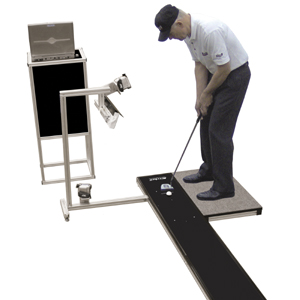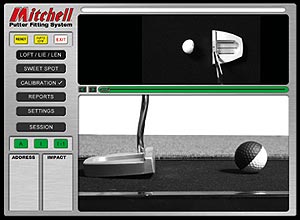Dynamic Putter Fitting
By Ed Mitchell, Mitchell Golf Company
In recent years putter fitting has increasingly become popular. Several putter manufacturers have offered putter fitting systems, namely Slazenger, Kirk Currie, Jack Nicklaus, Ping, and Henry Griffitts. Other manufacturers have offered putters with adjustable weights and Wilson now offers an oversized mallet that has inter-changeable plates for different sight lines.
Putter fitting is primarily the process of adjusting loft & lie angles and correctly fitting the length of the putter to the individual. In addition the putter style, i.e. offset, face balance, and center shaft, should be considered. Mitchell Golf Equipment Company introduced its first putter loft/lie angle machine in 1991. At the same time their putter fitting gauge was offered as part of the fitting process.
All of the previously mentioned putter fitting systems and processes are a static fit. But now Mitchell Golf Equipment Company offers a dynamic putter fitting system capable of measuring the putter head position at address and impact. This new system gives any golfer the opportunity to experience the same putter fitting that the tour professionals receive. A few putter manufactures have putter fitting studios for their staff professionals but they do not offer it to the everyday golfer.
In this article, I am going to describe what dynamic putter fitting is about and how it can help golfers lower their scores. In follow-up articles, I will explore in more detail what affect the putter head position at impact has on the ball for direction, distance and skidding.
Dynamic putter fitting is the ability to measure certain parameters from the putter head making contact with the golf ball. A perfectly struck putt is one where the ball started straight on line, rolled at the correct speed and traveled the exact distance to fall into the cup. We can debate if the speed of the ball should be enough to just fall in the cup, finish 6 inches behind the hole or stop exactly beside the hole. My preference is to make sure the ball goes into the cup regardless of how fast it is rolling.
In order to achieve the perfect putt, certain things must happen at impact of the putter head with the ball. First, the putter head should be square to the intended line. Second the putter head should contact the ball at its sweet spot. The sweet spot can be defined as the heel to toe balance point on the face of the putter head. If the ball is struck there, the optimum amount of energy is transferred to the ball. There is less twisting of the putter head (higher moment of inertia), and the best feel is transmitted to the golfers hands. Third, the appropriate amount of loft must be imparted on the ball to minimize ball skidding. This ensures the ball will turn over quickly and begin a true roll with less chance of getting off line.
The dynamic putter fitting process can be defined as measuring the aim of the putter head, ball contact position, loft of the putter face, the amount of skid distance and the speed of the ball once it starts rolling. Adjusting the putter’s length, loft/lie angles, and giving consideration to the putter style can improve putting consistency.
This is achieved through two or three putting sessions. I recommend the golfer making about 6 putts with their existing putter to gather information about their putting tendencies. Next the golfer needs to be measured for putter length and lie angle while in the proper putting posture. The proper posture is defined as a comfortable position with the eyes either directly over or just inside the intended putting line. The arms should hang freely from the shoulders and the hand position should be vertical to the ground (no forward or back press). This ensures the loft on the putter will be the effective loft at impact.
A putter of the fitted length and lie angle should be dynamically tested in a second session. The data from the first two sessions can be compared for consistency and further fitting adjustments. A third session can be performed for comparison after additional adjustments to the putter are made or after substituting a different putter style.
The objective of the dynamic putter fitting process is to improve the consistency of the golfer’s ability to aim the putter on the intended line, to repeatedly make solid contact, to impart the correct amount of loft on the ball to minimize skidding, and to roll the ball at a consistent speed to maintain a controllable distance.
In my next article, I will explore examples of dynamic putter fittings Mitchell Golf Equipment Company has done. Examples of the causes and effects of the three fitting parameters mentioned above will be shown including a video of ball skid. I am sure you will find this very interesting.



